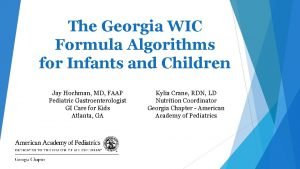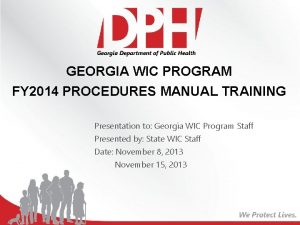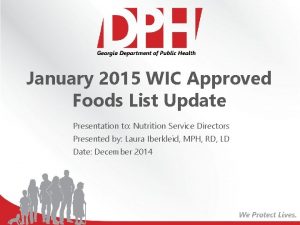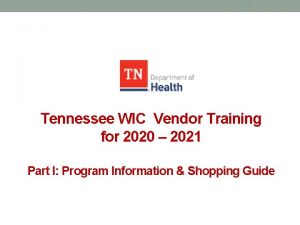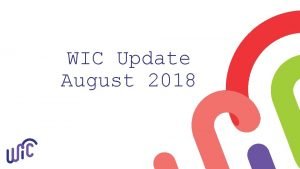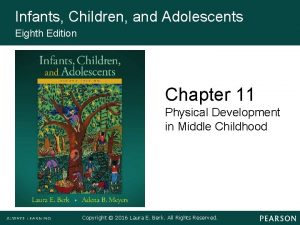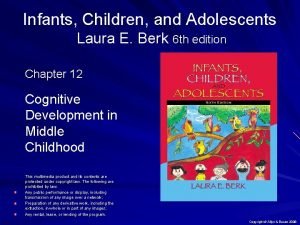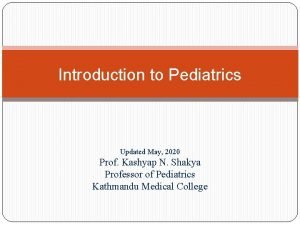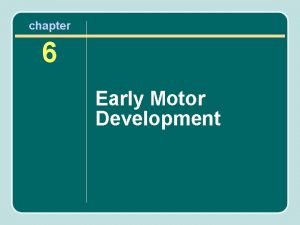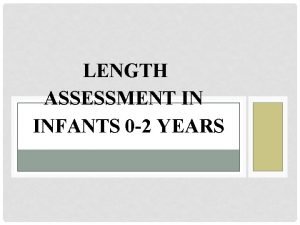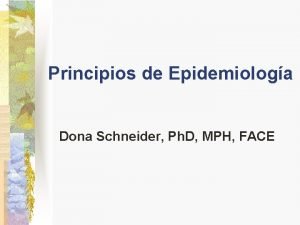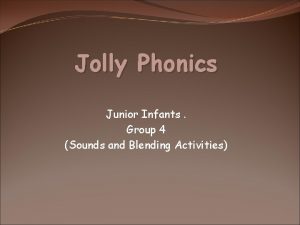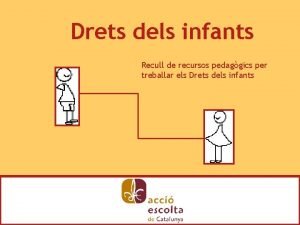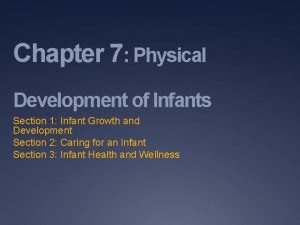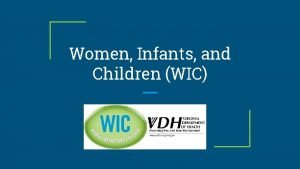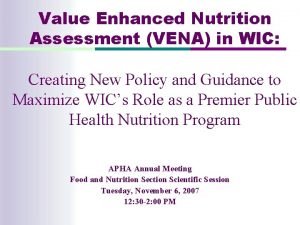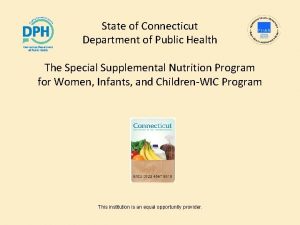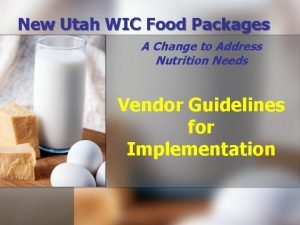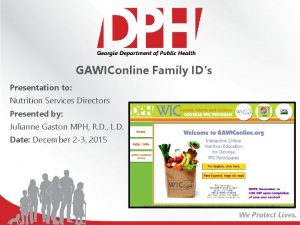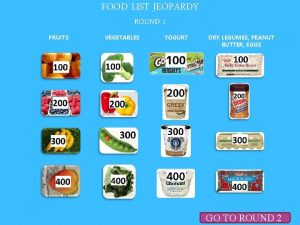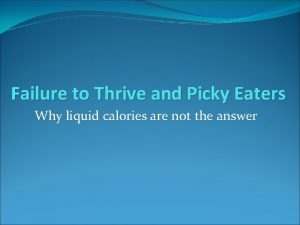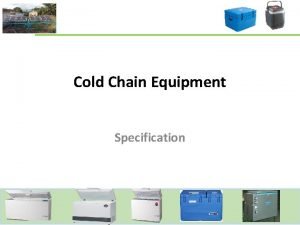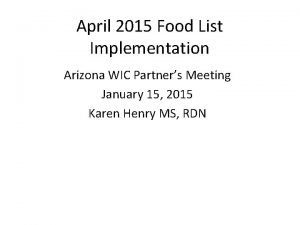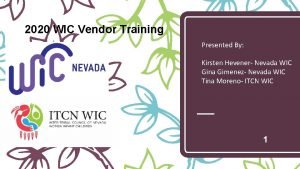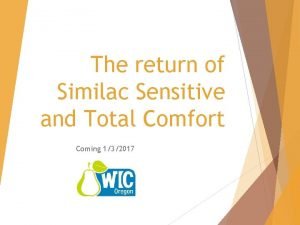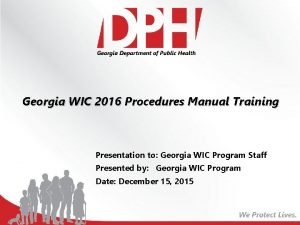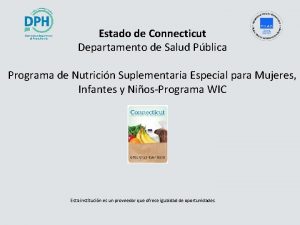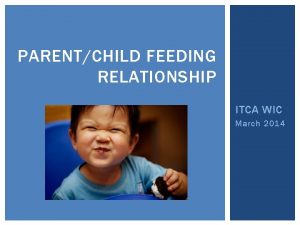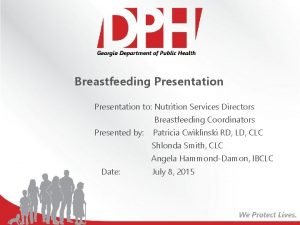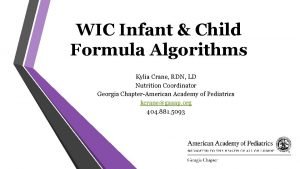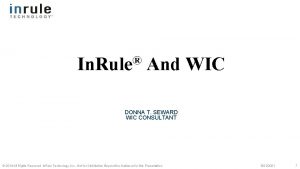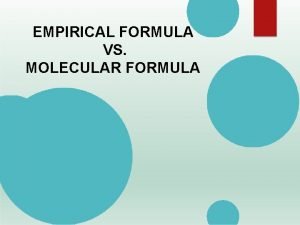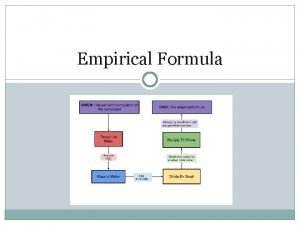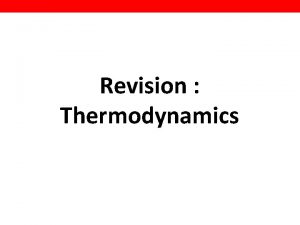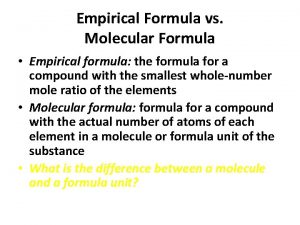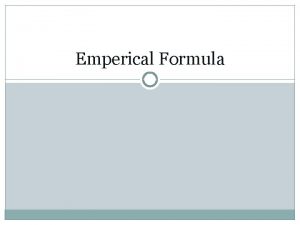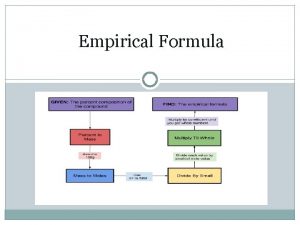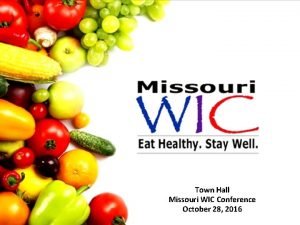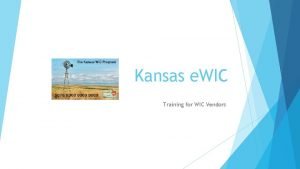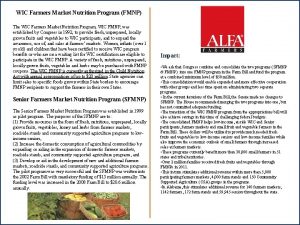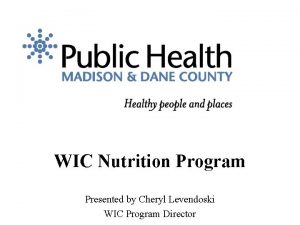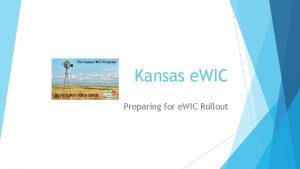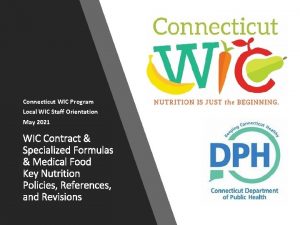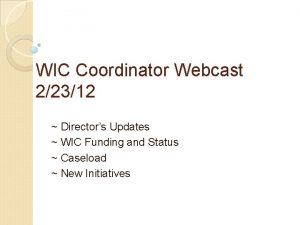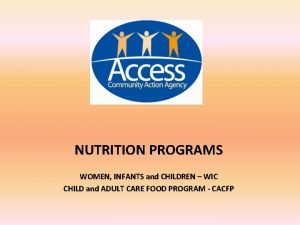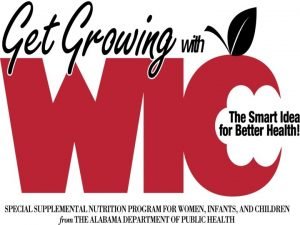The Georgia WIC Formula Algorithms for Infants and
















































- Slides: 48

The Georgia WIC Formula Algorithms for Infants and Children Jay Hochman, MD, FAAP Pediatric Gastroenterologist GI Care for Kids Atlanta, GA Kylia Crane, RDN, LD Nutrition Coordinator Georgia Chapter - American Academy of Pediatrics

Disclosures In accordance with the Accreditation Council for Continuing Medical Education (ACCME) Standards, all speakers are required to disclose, to the program audience, any real or apparent conflicts of interest to the content of their presentation. Neither Jay Hochman, MD, FAAAP or Kylia Crane, RDN, LD have any financial relationships to disclose relevant to this presentation.

The Georgia WIC Formula Algorithms for Infants and Children Objectives Describe the tiered approach to selecting special infant and child formulas for participants of the Georgia Special Supplemental Nutrition Program for Women, Infants, and Children (WIC) Identify approved special formulas for infant and children participants of the Georgia WIC Program Describe the standard milk and milk alternative food package options for the healthy child, age 1 -5, participating on the Georgia WIC Program

Formula Algorithm for Infants Background Created in 2012 by Stanley Cohen, MD, Pediatric Gastroenterologist, through a contractual agreement funded by the Georgia WIC Program Disseminated statewide Trainings for WIC staff, pediatricians, family physicians, and pediatric nurses

Formula Algorithm for Infants (cont. ) Rationale Specialty formulas prescribed more often than expected Formula prescription should be medically indicated Decision should not be based on manufacturer biased marketing or parental influence Guidance needed for common conditions: § Gastroesophageal reflux § Rectal bleeding/colitis Infantile colic/irritability § Malabsorption § Decreased weight gain § Allergies §

Formula Algorithm for Infants (cont. ) Objectives Identify common gastrointestinal (GI) conditions in which specialty formulas are medically indicated Identify evidence based recommendations for specialty formula selection Increase prescribing specialty formulas based on medically appropriate, WIC approved diagnoses Decrease parental influence in the prescribing of specialty formulas

Formula Algorithm for Infants (cont. ) Optimal Infant Nutrition Breast is best! Composition of breastmilk serves as basis formula, but cannot be duplicated Casein to whey ratios can be adjusted to be similar to breastmilk, but types of casein and whey in cow’s milk are different Formula manufacturers focus is to duplicate outcomes

Formula Algorithm for Infants (cont. ) 2017 Revisions Review of literature validates current evidence: No changes to algorithm Resource guide update to reflect formulas currently available on the market Reprint and distribution to WIC staff in April 2017 Pediatricians received infant algorithm as a part of the WIC Physician’s Kit mailing in June 2017


Formula Algorithm for Infants (cont. ) Tier 1: Breastmilk and Cow’s Milk Based Formula

Formula Algorithm for Infants (cont. ) Tier 2: Rice Starch Formula and Soy Formula

Formula Algorithm for Infants (cont. ) Tier 3: Hydrolyzed Formulas

Formula Algorithm for Infants (cont. ) Tier 4: Amino Acid Elemental Formula



Formula Algorithm for Infants (cont. ) Summary A tiered approach to prescribing formulas should be considered based on medical need and cost-effectiveness. Tier 1: Breastfeeding is recommended as optimal nutrition. If formula is provided, start with “routine” cow’s milk based formula Tier 2: Rice starch formula and soy formulas are indicated by diagnoses of complicated gastroesophageal reflux disease (GERD), and milk protein allergy/intolerance or sensitivity respectively

Formula Algorithm for Infants (cont. ) Summary Tier 3: Extensively hydrolyzed formula with MCT oil and/or protein hydrolysates are indicated by diagnoses of malabsorption and milk protein/soy protein allergy respectively Tier 4: Amino acid elemental formula is indicated when no improvement is made with tier 3 hydrolyzed formulas

Formula Algorithm for Children Background New project led by pediatric gastroenterologists, Stanley Cohen, MD and Jay Hochman, MD through a contractual agreement between GA WIC and the Georgia Chapter of the American Academy of Pediatrics (GA AAP) Same premise as infant algorithm • Confusion on varied toddler and child formulas and additives • Over-prescribing of specialty formulas • Formula issuance not consistent with anthropometric measurements for enhanced calorie formulas

Formula Algorithm for Children (cont. ) Basis Need to create expanded special formula algorithm that provided guidance on formulas for children § What is an appropriate diagnosis and when to issue toddler formulas? § Evidence based guidelines Format similar to the Formula Algorithm for Infants for ease of use by medical providers and WIC staff

Formula Algorithm for Children Objectives Apply the tiered approach to selecting child formulas based on medical indications. Increase prescribing specialty formulas based on medically appropriate, WIC approved diagnoses. Decrease prescribing of formulas based on manufacturer biased marketing or parental influence. Identify feeding options on Georgia WIC for children who don’t have feeding or nutritional concerns.


Tier 1 & Tier 2: Standard Milk Package and Milk Alternatives

Formula Algorithm for Children (cont. ) Tier 1: Standard Cow’s Milk Food Package Children age 1 -5 without feeding or nutrition concerns Georgia WIC provides whole milk for children age 1 -2 years old and fat free or 1% milk for all children over the age of 2.

Human Milk as an “Alternative” Breastfeeding Toddlers Breastfeeding may continue after age 1 for as long as mother and baby desire The World Health Organization (WHO) recommends continued breastfeeding up to 2 years of age or beyond Although Georgia WIC does not provide a specific food package for breastfeeding toddlers, clinics have qualified staff that are able to provide breastfeeding support and resources as necessary Children may be provided a food package without any milk or milk alternative if the parent/caregiver/guardian requests

Formula Algorithm for Children (cont. ) Tier 2: Milk Alternatives Authorized for dietary preference, lactose intolerance, and cow’s milk protein allergy/intolerance Georgia WIC Approved Options: Soy Milk § Soy milk can be used as an alternative to cow’s milk and provides sufficient protein § Rice and almond milks are not approved by the United States Department of Agriculture (USDA) for use on the WIC Program and tend to have lower protein content.

Formula Algorithm for Children (cont. ) Tier 2: Milk Alternatives Georgia WIC Approved Options: Lactose Reduced Milk § Lactose intolerance is an infrequent issue for children under age 5 § Lactose reduced milk is not recommended for cow’s milk protein allergies as it still contains milk proteins Goat’s Milk § Available though Georgia WIC as a dietary preference and to meet religious/cultural needs § Georgia WIC provides goat’s milk in whole, low-fat, and evaporated options

Formula Algorithm for Children (cont. ) Tier 2: Milk Alternatives Cow’s Milk Protein Allergy (CMPA) CMPA is a predominant cause of nutritional-induced allergies and may present with non-immunoglobulin E (Ig. E) and/or Ig. E mediated reactions. § Non-Ig. E mediated reactions are considered delayed-onset reactions and can manifest as GI and skin reactions. § Ig. E-mediated allergy is consider as immediate onset reaction, as symptoms appear rapidly after exposure and typically affect one or more of the GI, skin and respiratory systems.

Formula Algorithm for Children (cont. ) Tier 2: Milk Alternatives Cow’s Milk Protein Allergy (cont. ) 10 -14% of children with CMPA also have reactions to soy. Those who have non-Ig. E reactions to milk may have a 40% cross reactivity to soy. The majority of children are likely to tolerate soy which allows most children to use soy milk safely and with less expense than immediately employing an extensively hydrolyzed formula. CMPA should be diagnosed carefully so that children are not excluded from some formulas unnecessarily.

Formula Algorithm for Children (cont. ) Tier 2: Milk Alternatives Cow’s Milk Protein Allergy (cont. ) Goat’s milk is not a safe alternative to cow’s milk for children with cow’s milk protein allergy. In studies, the risk of allergy (resulting in symptoms) to goat's milk or sheep's milk in a person with cow's milk allergy is about 90%.

Tier 3 • Protein Hydrolysate Formulas • Enteral Nutrition • High Calorie Formulas

Formula Algorithm for Children (cont. ) Tier 3: Protein Hydrolysate, Enteral Nutrition, and High Calorie Formulas Authorized for soy/multiple allergies, malabsorption, feeding difficulties, or inadequate growth Formulas with high MCT oils are helpful for conditions that cause malabsorption. These formulas are also indicated in cardio/pulmonary, chylous effusions, and for some forms of liver disorders.

Formula Algorithm for Children (cont. ) Tier 3: Protein Hydrolysate, Enteral Nutrition, and High Calorie Formulas Feeding difficulties may include: decreased intake, neurodevelopmental delays, oral motor issues, textural issues, autism spectrum disorders, and tube feeding. Georgia WIC has a full listing of enteral products that include intact proteins, blenderized, elemental, caloric dense, and reduced calorie (for obese patients or those bed/wheel chair bound) formulas.

Formula Algorithm for Children (cont. ) Tier 3: Protein Hydrolysate, Enteral Nutrition, and High Calorie Formulas Inadequate growth may include underweight (wt/ht <5 th percentile for age or BMI/age <5 th percentile for age), no weight gain > 3 mo. , failure to thrive, cardio/pulmonary conditions. Dietary intervention is a vital step for children with feeding difficulties and inadequate growth. Increasing calories from food should be the first step initiated before using a commercially available high calorie nutritional.

Formula Algorithm for Children (cont. ) Tier 3: Protein Hydrolysate, Enteral Nutrition, and High Calorie Formulas (cont. ) A high calorie formula/nutritional is a Georgia WIC Approved formula for a child age 1 and up that is at least 30 calories per oz.

Tier 4 • Amino Acid Elemental Formulas • Metabolic/Specialty Formulas

Formula Algorithm for Children (cont. ) Tier 4: Amino Acid/Peptide Formulas Metabolic Formulas Authorized for severe/multiple food allergies and malabsorption and for children that have no improvement while on a Tier 3 formula. When a patient is doing well on an amino acid formula for a prolonged period of time, possibly a year, it is reasonable to revert to a protein hydrolysate formula. Children that are diagnosed with metabolic/renal conditions can receive these specialty products with medical documentation. All Georgia WIC Approved formulas including metabolic and specialty formulas/nutritionals for chronic conditions are listed on the Georgia WIC website wic. ga. gov under “Formula Resources”.

Formula Algorithm for Children (cont. ) Resource Guide The resource guide is design to accompany the algorithm and provide detailed information on the specific milk/formula that is available through Georgia WIC for the tier indicated. The resource provides the following information: Product Category Product Name Manufacturer Form Size Flavor Composition Whether Medical Documentation is Required Medical Indications








Next Steps Outreach, Promotion and Evaluation The Georgia Pediatrician newsletter articles Office visits to providers Blast communications (e-mails and fax) Websites (GA WIC and GA AAP) Disseminate at biannual meetings for pediatricians and pediatric staff (nurses, medical assistants, and practice managers) Evaluations to determine use and effectiveness - Provider visits and follow-up - Membership surveys

Conclusions The formula algorithms and resource guides can be used to help guide through the decision making process with prescribing formulas through Georgia WIC. When a child has no feeding or nutritional concerns, a standard milk food package or alternative package should be considered first before prescribing child formulas as it would not be authorized through Georgia WIC. Soy/multiple allergies, malabsorption, feeding difficulties', inadequate growth, and metabolic/renal conditions are all indications for prescribing special child formulas.

Evaluation & CME Each registered attendee will be receiving an email with a short evaluation of our webinar today. The evaluation will include information for Continuing Medical Education (CME) credit and WIC Nutrition Continuing Education Units (CEU) for this webinar. Please contact Kylia Crane at kcrane@gaaap. org or 404 -881 -5093 with any additional questions.

Thank you for your participation! The resources discussed today are all available at wic. ga. gov in the “Health Care Provider Information” section. If you are interested in receiving hard copies, please contact Kylia Crane at kcrane@gaaap. org or 404 -881 -5093.
 Wic formula georgia
Wic formula georgia Georgia wic formula
Georgia wic formula Georgia wic
Georgia wic Wic juice
Wic juice Integrated eligibility system (ies)
Integrated eligibility system (ies) Tn wic food list 2021
Tn wic food list 2021 Nc wic formula
Nc wic formula Gains in perspective taking permit the transition to
Gains in perspective taking permit the transition to Discontinuous development psychology
Discontinuous development psychology Creative curriculum intentional teaching cards
Creative curriculum intentional teaching cards Infants, children, and adolescents 8th edition
Infants, children, and adolescents 8th edition Infants and children 8th edition
Infants and children 8th edition Suprasternal retraction
Suprasternal retraction Infants age range
Infants age range Watson give me a dozen healthy
Watson give me a dozen healthy What are sentinel injuries
What are sentinel injuries Art ideas for senior infants
Art ideas for senior infants Chapter 9 intellectual development in the first year
Chapter 9 intellectual development in the first year Infant personality development
Infant personality development Rate limiters for infants
Rate limiters for infants Length board for infants
Length board for infants Chrisomes infants
Chrisomes infants Just phonics junior infants
Just phonics junior infants Dinamiques per treballar els drets dels infants
Dinamiques per treballar els drets dels infants Lisa attempts to retrieve her bottle
Lisa attempts to retrieve her bottle Chapter 7 physical development of infants
Chapter 7 physical development of infants History of wic
History of wic Wic juice
Wic juice Vena wic
Vena wic Wic approved milk brands
Wic approved milk brands Pars.state.wic
Pars.state.wic Oregon wic program
Oregon wic program Wic oatmeal
Wic oatmeal Gawiconline.org
Gawiconline.org Jeopardy fruits and vegetables
Jeopardy fruits and vegetables Wic yogurt
Wic yogurt Wic vaccine storage
Wic vaccine storage Wic approved yogurt
Wic approved yogurt Yogurt whole milk wic
Yogurt whole milk wic Wic similac total comfort
Wic similac total comfort Gwisnet
Gwisnet Formulas aprobadas por wic
Formulas aprobadas por wic Itca wic
Itca wic Pcdb wic
Pcdb wic Wic handelsroute
Wic handelsroute Itca wic
Itca wic Wic pcdb
Wic pcdb Iso 22301 utbildning
Iso 22301 utbildning Typiska drag för en novell
Typiska drag för en novell
